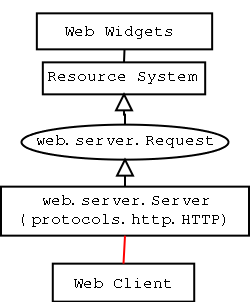Introduction
Twisted Web is a web application server written in pure Python, with APIs at multiple levels of abstraction to facilitate different kinds of web programming.
Twisted Web's Structure

When the Web Server receives a request from a Client, it creates a Request object and passes it on to the Resource system. The Resource system dispatches to the appropriate Resource object based on what path was requested by the client. The Resource is asked to render itself, and the result is returned to the client.
Resources
Resources are the lowest-level abstraction for applications
in the Twisted web server. Each Resource is a 1:1 mapping with
a path that is requested: you can think of a Resource as a
single page
to be rendered. The interface for making
Resources is very simple; they must have a method named
render which takes a single argument, which is the
Request object (an instance of twisted.web.server.Request). This render
method must return a string, which will be returned to the web
browser making the request. Alternatively, they can return a
special constant, twisted.web.server.NOT_DONE_YET, which tells
the web server not to close the connection; you must then use
request.write(data) to render the
page, and call request.finish()
whenever you're done.
Web programming with Twisted Web
Web programmers seeking a higher level abstraction than the Resource system should look at Nevow. Nevow is based on ideas previously developed in Twisted, but is now maintained outside of Twisted to easy development and release cycle pressures.